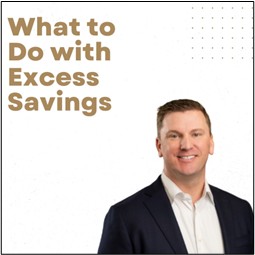By Marc C. Shaffer
Do you have Lazy Cash? Cash just sitting around in a general checking account or other location (mason jar, eek!) whittling away due to inflation and not WORKING for you?
In the years leading up to the pandemic, cash planning wasn’t a frequent topic of conversation. Most people focused on retirement contributions, debt management, or investment performance, rarely on how much cash to keep on hand or how to structure an emergency fund. It was often assumed that having “some” cash was enough, without much discussion about how much was too little, or too much.
Then COVID-19 hit, and everything changed.
The uncertainty sparked a deep desire for safety and liquidity. Understandably, many people held onto cash as a form of comfort and control. It was a financial security blanket during a time when very little felt secure.
As interest rates rose, that trend intensified. Suddenly, high-yield savings and money market accounts were paying 4%–5%, making it feel smart, even satisfying, to park large sums in cash. And for a while, that strategy made sense. It felt productive. But it’s important to remember that these elevated rates may not last forever, they’re closely tied to economic policy and could decline as conditions shift.
Now, we’re seeing a pattern.
Many clients and prospective clients are holding significantly more in cash than is typically recommended, well beyond what they need for emergency funds or near-term expenses. This surplus, while seemingly harmless, can create opportunity costs and stall progress toward long-term goals. We do not discourage the benefits of liquidity and safety, but want to help you think more intentionally about what to do once you’ve checked the box for financial security.
If you’ve built up a comfortable cash cushion, it might be time to ask: What’s next?
- Start by Defining Your Emergency Fund
Before deploying excess cash elsewhere, start by determining how much you truly need in reserves. We typically recommend an emergency fund that covers three to six months of essential living expenses, adjusted to reflect your personal situation, such as job stability, number of income streams, dependents, and overall risk tolerance. Once you’ve reached that target and placed those funds in a competitive-yield savings account (such as Flourish Cash or another high-yield option), everything beyond that balance could be considered “excess cash.”
- Eliminate High-Interest Debt
The next step is to look at any debt with interest rates higher than your savings yield. Carrying credit card balances, personal loans, or other high-interest obligations while sitting on extra cash doesn’t usually make financial sense. Paying down a credit card with a 20% interest rate is like earning a guaranteed 20% return, something nearly impossible to find in traditional investments. If you’re in this situation, accelerating debt payments can offer both financial and emotional relief.
- Reconnect With Your Goals and Bring Them Closer
Once debt is in check, shift focus to your personal goals. What were the dreams that didn’t make the cut in your initial financial plan? Maybe they felt aspirational or too far down the line. Extra cash is your chance to bring those goals forward:
- Home renovations or upgrades you’ve been postponing
- Funding for a child’s or grandchild’s future education
- Planning extended travel experiences
- Investing in a small business or creative venture
- Securing insurance or long-term care coverage
Think of this step as realigning your money with what matters most. It’s not just about shifting dollars, it’s about reshaping your life path.
- Consider a Taxable Brokerage Account for Long-Term Growth
When your emergency fund is solid and your goals are aligned, a taxable brokerage account (also called an after-tax account) can be a smart next move. It offers flexibility, growth potential, and liquidity; all of which make it a valuable complement to retirement and savings accounts. A few key benefits include:
- No early withdrawal penalties
- Broad investment options tailored to your goals and risk tolerance
- Tax strategies like loss harvesting and qualified dividends
- Access to funds without disrupting your long-term retirement plan
Unlike retirement accounts, taxable brokerage accounts allow you to save for the “in-between” years, those life moments before age 59½ that still require funding.
- Explore Charitable Giving and Legacy Gifting
If you’ve built a strong financial foundation and want to share your wealth with others, you may want to explore purposeful giving. Strategic gifting can create a lasting impact, not only financially but emotionally and generationally.
You might consider:
- Charitable giving through Donor-Advised Funds (DAFs)
- Annual gifting to family members, up to IRS limits, to help with education, housing, or career goals
- Establishing a legacy plan that outlines how your excess funds should support people and causes you care about, now and in the future
Giving doesn’t always have to wait. Sometimes the most meaningful impact comes while you’re still here to experience it.
Consider this flowchart: WHERE SHOULD MY NEXT DOLLAR GO?
Every Dollar Should Have a Purpose
Excess cash isn’t a problem, it’s an opportunity. But without direction, it often becomes dead weight in your financial plan. At Searcy Financial, we believe every dollar should have a job. Whether that job is protection, progress, or purpose, it deserves intentional placement. If you’re sitting on more cash than usual and wondering what to do next, this is your sign to start a conversation. We’d love to help you align your money with what matters most.
Let’s Make Your Money Matter
Ready to create a purpose-driven plan for your savings? Let’s talk about how to use your excess cash to support your next chapter, with clarity and confidence.
Visit these blogs for additional information:

